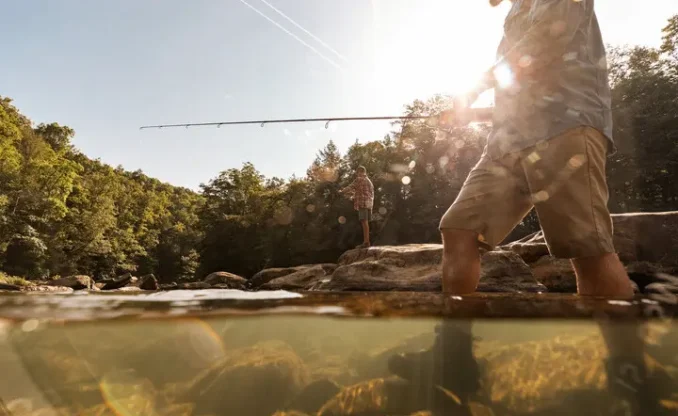Family: Esocidae
Common Family: The Pike Family
Name: Muskellunge (Musky)
Scientific Name: Esox masquinongy
Ecological Description
A Legendary Game Fish
Muskellunge are considered by many anglers to be the premier freshwater fish because of their large size and fighting spirit. Muskies can live 20 years or more. Adults are 30-50 inches in length and can weigh more than 40 pounds. These toothy apex predators inspire an obsession among some anglers, who choose to fish for nothing else.
Musky are native fish to the Ohio River drainage basin, which includes many waters in West Virginia. Musky also been introduced to other areas through WVDNR stocking efforts to create trophy fisheries.
Physical Characteristics
These long, cylindrical-shaped fish are instantly recognizable by their snout and razor-sharp teeth. Their coloration varies from olive to brown, fading to a lighter flank and titanium-white belly. Spots and barring add further camouflage, making them nearly invisible to unsuspecting prey.
Hunting Behavior
Muskies are solitary hunters. They lurk near cover, using a coil-and-spring attack to ambush prey from woody debris or submerged structures. Their diet includes soft-rayed forage fish like suckers and gizzard shad, but they’ve also been known to eat birds, small mammals, and amphibians.
Rare and Elusive
As top-level predators, musky exist in low densities compared to other sport fish. That rarity has earned them the nickname “the fish of 10,000 casts.” Catching one often requires patience, persistence, and skill.
Migration and Spawning
In many rivers, individual musky roam large distances—some have been documented traveling more than 50 river miles annually. Spawning occurs in the spring as water temperatures approach 55°F. During this time, males and females migrate upstream to riffle areas for courtship and spawning.
Habitat
Muskellunge are found in a variety of waters in West Virginia—from small streams to large rivers, lakes, and reservoirs. Their native range includes the Ohio River drainage, but WVDNR stocking efforts have expanded their presence beyond historic boundaries. Muskies prefer slack water with dense cover such as woody debris, downed trees, and other submerged structures.
Conservation Issues
Habitat loss and water quality degradation are two of the biggest threats to muskellunge populations. In naturally reproducing streams, siltation and other land-use-related issues can reduce survival and recruitment.
Historically, overharvest was a significant threat. Since the 1990s, angler attitudes have shifted. Today, many anglers practice catch-and-release, especially for large, long-lived fish. This change has been influenced by stricter harvest regulations and outreach by fisheries managers and sportsmen’s groups.
Facts
The current International Game Fish Association all-tackle world record musky, caught by Cal Johnson in 1949 from Lake Court Oreilles in Wisconsin, weighed 67 pounds, 8 ounces. For the most current West Virginia state musky record catches, check page 28 in the West Virginia Fishing Regulations Summary.
Muskies are curious and often follow lures to the boat without striking. A common tactic is to move the lure in wide arcs or a “figure-8” beside the boat to trigger a reaction strike. Boat-side strikes are one of the most thrilling aspects of musky fishing.
West Virginia is also home to several renowned musky lure makers whose handcrafted baits are used by anglers across the country.
Similar Species
Muskellunge are often confused with northern pike, chain pickerel, and tiger muskellunge (a northern pike/muskellunge hybrid).
- Northern Pike and Chain Pickerel: Rare in West Virginia, but present.
- Tiger Muskellunge: Stocked by WVDNR in Big Ditch, Charles Fork and Mountwood Lakes to create novelty fisheries. These hybrids have prominent side barring, grow larger than pike and strike aggressively.



